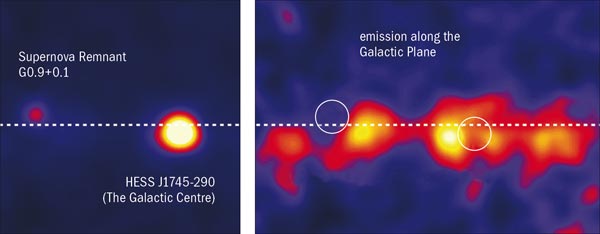Although the super-massive black hole at the centre of our galaxy seems very quiet compared with those seen as quasars in remote galaxies, it might be a giant proton accelerator more powerful than CERN’s Large Hadron Collider. This at least is what a group of theorists at the University of Arizona suggests to explain the very high-energy gamma-ray source at the centre of the Milky Way.

The galactic centre is a complex region with a large density of both compact and diffuse energetic sources. At the very heart of the galaxy individual stars have been observed to orbit an invisible object with an inferred mass about 3 million times that of the Sun. There is almost no doubt now that this object is a super-massive black hole. It remains a mystery, however, why the output of this black hole is so dim compared with the tremendous energy released by black holes of comparable mass in active galactic nuclei.
Another puzzle is that this quiet object is apparently a strong source of gamma rays at tera-electron-volt energies. The HESS (High-Energy Stereoscopic System) array of Cherenkov telescopes in Namibia finds the position of the gamma-ray source to be coincident with that of the black hole to a relatively high accuracy. If the gamma rays – as suggested by the data – do indeed originate from the black hole rather than from the nearby supernova remnant Sagittarius A East, understanding their production mechanism is a theoretical challenge.
Direct generation of tera-electron-volt photons around the black hole seems unrealistic, so theorists have explored indirect processes. The most likely scenario is that relativistic protons are accelerated in the vicinity of the black hole, diffuse along magnetic field lines and eventually collide with ambient hydrogen nuclei. Such proton–proton scatterings would produce pions, which would rapidly decay into pairs of photons. Several recent studies attempted to explain how these protons could be accelerated to energies of up to hundreds of tera-electron-volts close to the black hole’s event horizon.
To address this question further, one group of theorists has now tried instead to figure out whether such relativistic protons could be at the origin of the gamma-ray emission observed by HESS. David Ballantyne and colleagues from the University of Arizona, Los Alamos National Laboratory and the University of Adelaide, model the diffusion of relativistic protons in a cube with sides 20 light-years long centred on the Milky Way’s super-massive black hole. Using a realistic density distribution, they study the random-walk trajectories of 222,000 simulated protons as they interact with the turbulent magnetic field in the volume.
Assuming the magnetic field intensity to be proportional to the gas density, the team finds that about a third of the protons will produce gamma rays in the circumnuclear torus around the black hole. These scatterings at only several light-years from the galactic centre could be responsible for the point-like gamma-ray source found by HESS, but only if the initial proton spectrum is very hard, with a power-law index of 0.75. The majority of relativistic protons would travel much longer distances before interacting with interstellar gas and could be responsible for the diffuse glow of the central galactic ridge that HESS also sees. That these two sources of tera-electon-volt photons with very different spatial distributions could have the same origin gives strength to this model.
Further reading
D R Ballantyne et al. 2007 Astroph. Journal 657 L13.








